Tourist hammocks: features, varieties, rules for selection and installation
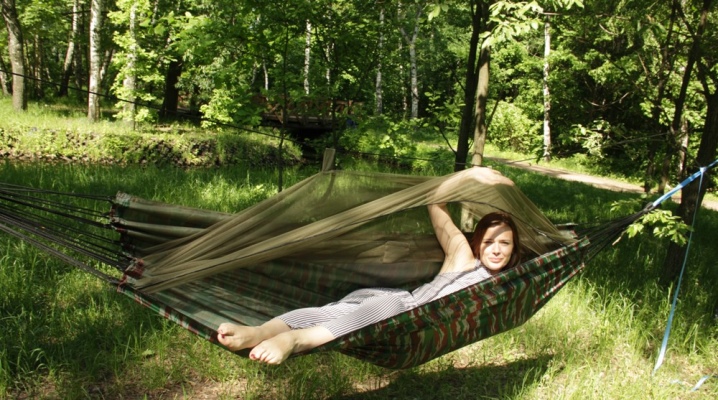
A hammock is an indispensable item in any hike or camping. You can hang it almost anywhere, and most importantly - quickly and without unnecessary tools. And after a few minutes it is ready to use. All that is needed is two trees standing close to each other. There are hundreds of varieties of hammocks on the market now. Single, double or more local or even models for the whole company. Everyone can choose what they really like. From classic hammocks and armchairs to real hanging tents for several people. But how to understand all this diversity?
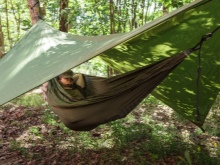


Specifications
Most quality hammocks are made of dense, tear-resistant fabric, which does not allow moisture to pass through. True, because of this, a puddle can form in the hammock during the rain. For fastening, a rope with a thickness of 0.7 to 1.3 cm is usually used. This allows the product to be securely fastened. Hammocks are used both for hiking and in design, for example, summer cottages.
Of course, camping hammocks are made of denser and more durable fabric than summer cottages, and there are more varieties of them.
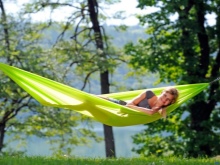
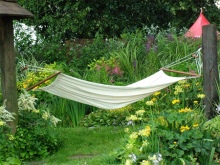
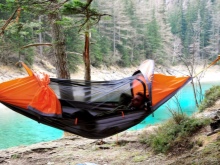
Advantages and disadvantages
It is impossible to say unequivocally what is good and what is bad in a particular model, because all users have completely different requirements. So let's just look at the main features of hiking hammocks. And the first is, of course, light weight. Compared to a conventional camping tent, a hammock is much less burdensome to travel. It has almost no metal or other heavy elements that would significantly increase its weight.
For a hammock, you do not need to look for a place with a flat surface. All that is required are 2 (sometimes 4) supports on which the hooks can be attached. Finding such a place, if you went hiking in the forest, will not be difficult. And fixing a hammock is easier than putting up the same tent. You just need to fix it at a comfortable height. No foldable or detachable items.
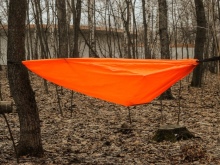
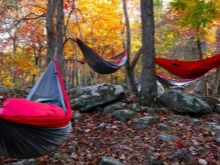
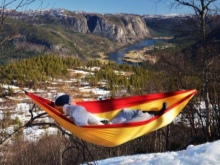
Sleeping bags can be placed in special hammock tents, and an awning can be pulled on top. Sleeping in such a place is a pleasure, and your back will not hurt from the hard ground.
It is also important to note that ants, snakes and other unwanted guests will not reach you in the hammock. And the inhabitants of trees, for example, squirrels, will not dare to come down to you.
Two main points can be distinguished from the unpleasant:
- small size, designed for only 1-2 people;
- it is much easier to freeze in a hammock on cold nights.

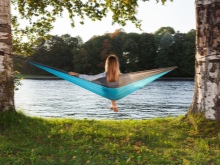
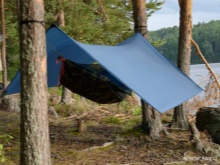
Varieties
Hammocks are distinguished not only by the type of material from which they are made, but also by their shape and size. There are several basic types of hanging camping hammocks.
- Camping hammocks... They are divided into summer and winter. They can be equipped with numerous pockets or even whole mattresses, there are also models with a mosquito net and an awning. However, it will be necessary to spend money on such an option in the range of 10,000-30,000 rubles. They can truly be called aerial tents. Without a doubt, a big plus is the fact that the awning and the insect net are attached separately and create a kind of cocoon around the tent. Some models are equipped with a down layer that can protect you from cold and wind even in winter.
However, it is not possible to use such options in the summer due to the fact that they are hot.

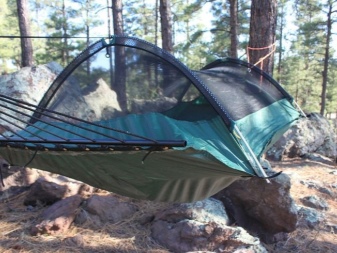
- Cocoon. These hammocks are shaped like pea pods. It seems that they provide everything that can be useful on a hike - a mosquito net, and insulation, and an awning, and many pockets along the entire length of the product. The summer version is ultralight without additional warm lining, so it is easy and convenient to take one on any trip. And the insulation will save even the most severe winter frosts.
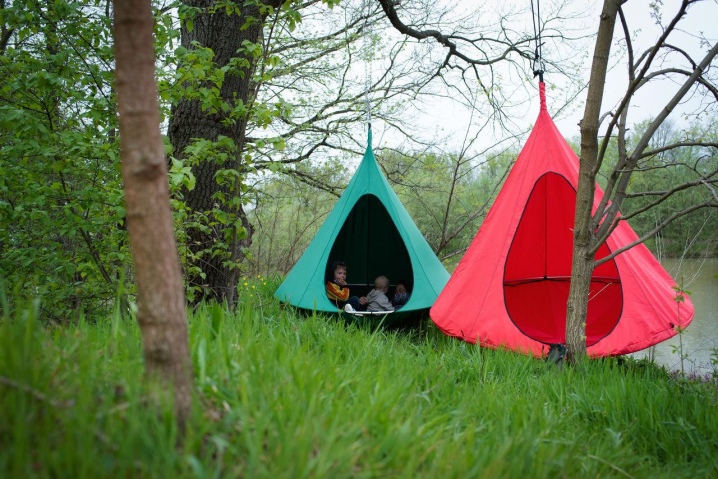
- Double bar hammocks... This is a very convenient solution for those who like to go outdoors with a friend or soul mate. The crossbar, which is located in the middle of the hammock, prevents both people from rolling to the center and piling them on top of each other.
However, it is worth remembering that such structures are very wobbly - with a strong wind or movement of people inside relative to the axis, the hammock can easily turn over. Therefore, taking such a hammock on a hike, knowing that the weather will be windy, is not worth it.
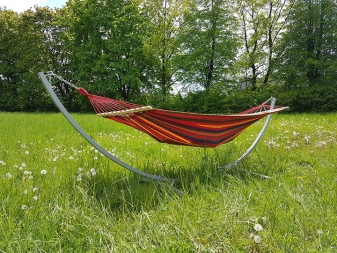
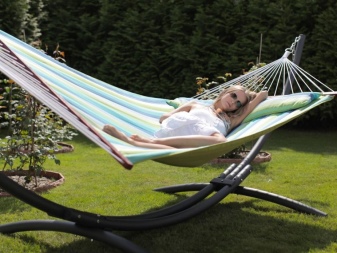
- DIY hammock. There is nothing better than a thing that you yourself have done, based on your needs and requirements. You can sew pockets, clasps, or even make impromptu clear windows on it, not to mention provide protection from insects. All that limits you is your own imagination and the required range of functionality of the future product.
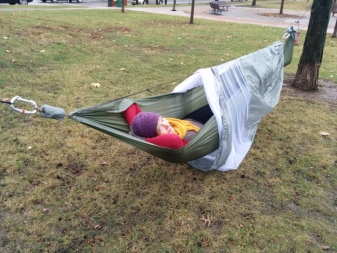
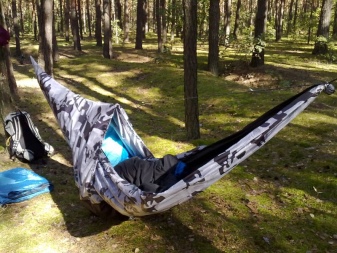
How to choose?
The hammock is the choice of those who like extreme and unusual hikes. It is also indispensable when hiking long distances, as it is noticeably lighter than a tent.... In dense forests where wild animals live, it is also better to go with a hammock, since in it you will not be disturbed by nocturnal animals, for example, raccoons. When choosing a hammock, be guided first of all by the purpose for which you are purchasing it. If you need it for summer weekend hikes with friends, then pay attention to the small models with an awning to protect from the rain and a detachable mosquito net.
If you are an avid lover of outdoor activities both in summer and winter, then an important element of your future purchase should be a special insulation layer... Otherwise, it will simply not be possible to warm up in a hammock, and it is unlikely that it will be possible to make a fire near it because of the trees on which it hangs. Also decide on whether you need a single or double hammock. Doubles tend to be a little more expensive, but even if you take it with you on a solo hike, you probably won't experience any problems.
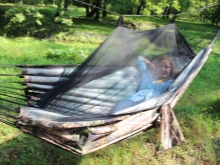
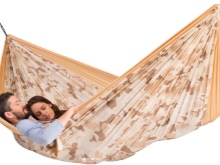
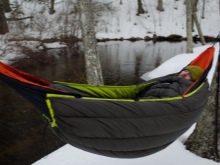
Pay special attention to the material from which the product is made. Cheap and low-quality hammocks are usually made from synthetic nylon, while a real camping hammock will be made from natural linen or coarse calico with a special water-repellent impregnation.
Examine the lines carefully. There should be no puffs on them, much less cuts. Your own safety depends on it.
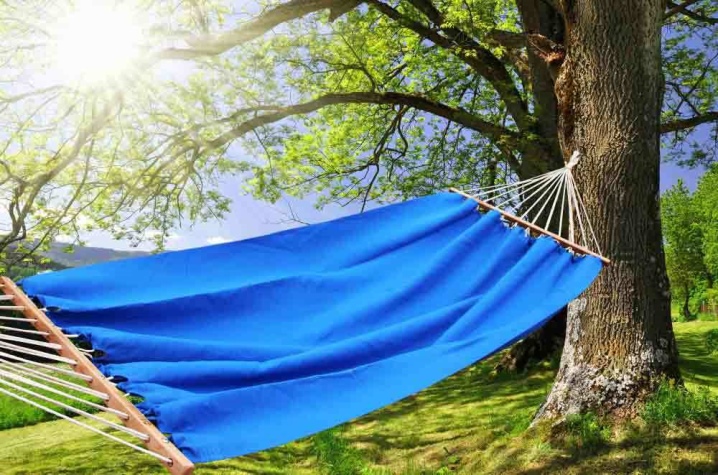
Installation tips
Usually, placing a bed takes about 5-7 minutes, but the first time there may be some problems, so we will analyze in detail how to hang a hammock. Take the base out of the case and spread it out. Fasten the slings on the trees, the distance between which is about 3-4 meters. If the slings are smooth, tie a few knots on them with a distance of 15-20 cm in the place where they wrap around the tree. This is necessary so that they better adhere to the unevenness of the bark and do not move out during use.
A special niche for backpacks and other things can be located below. It usually has pockets or even several compartments in which you can stow your belongings. A dense mattress is laid at its bottom, which prevents things from falling through and does not allow the hammock to warp. In the winter season, this layer plays the role of insulation that protects the interior from wind and frost.
The awning on most hammocks is attached with the main body, but it can also be pulled separately. In this case, it will need to be fixed in the same way as the hammock itself.
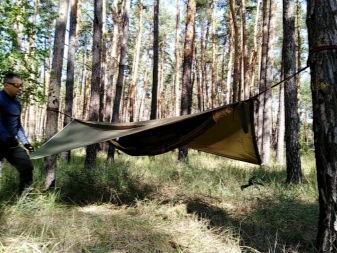

Make sure not to leave creases on it, as water can collect in them when it rains. Even if the fabric does not leak, it can be problematic to free it from the water without soaking the hammock.
It is not difficult to choose a hammock that will suit your liking. Many modern models now even include special instructions for attaching the hammock to the slings and directly to the tree. This solution is much more convenient than a conventional camping tent, and has many advantages over it.
For an overview of the tourist hammock, see the following video.



































































The comment was sent successfully.